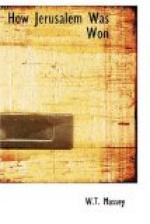The 60th Division came over from Salonika and we were delighted to have them, for they not only gave us General Bulfin as the XXIst Corps Commander, but set an example of efficiency and a combination of dash and doggedness which earned for them a record worthy of the best in the history of the great war. These London Territorials were second-line men, men recruited from volunteers in the early days of the war, when the County of London Territorial battalions went across to France to take a part on a front hard pressed by German legions. The 60th Division men had rushed forward to do their duty before the Derby scheme or conscription sought out the cream of Britain’s manhood, and no one had any misgivings about that fine cheery crowd.
The 10th Division likewise came from Salonika. Unfortunately it had been doing duty in a fever-stricken area and malaria had weakened its ranks. A little while before the autumn operations began, as many as 3000 of its men were down at one time with malaria, but care and tonic of the battle pulled the ranks together, and the Irish Division, a purely Irish division, campaigned up to the glorious traditions of their race. They worked like gluttons with rifle and spade, and their pioneer work on roads in the Judean hills will always be remembered with gratitude.
The cavalry of the Desert Mounted Corps were old campaigners in the East. The Anzac Mounted Division, composed of six regiments of Australian Light Horse and three regiments of New Zealand Mounted Rifles, had been operating in the Sinai Desert when they were not winning fame on Gallipoli, since the early days of the war. They had proved sterling soldiers in the desert war, hard, full of courage, capable of making light of the longest trek in waterless stretches of country, and mobile to a degree the Turks never dreamed of. There were six other regiments of Australian Light Horse and three first-line regiments of yeomanry in the Australian Mounted Division, and nine yeomanry regiments in the Yeomanry Mounted Division. The 7th Mounted Brigade was attached to Desert Corps, as was also the Imperial Camel Corps Brigade, formed of yeomen and Australians who had volunteered from their regiments for work as camelry. They, too, were veterans.
All these divisions had to be trained hard. Not only had the four infantry divisions of XXth Corps to be brought to a pitch of physical fitness to enable them to endure a considerable period of open fighting, but they had to be trained in water abstinence, as, in the event of success, they would unquestionably have long marches in a country yielding a quite inadequate supply of drinking water, and this problem in itself was such that fully 6000 camels were required to carry drinking water to infantry alone. Water-abstinence training lasted three weeks, and the maximum of half a gallon a man for all purposes was not exceeded, simply because the men had been made accustomed to deny themselves drink except when absolutely necessary. But for a systematic training they would have suffered a great deal. The disposition of the force is given in the Appendix.[1]




